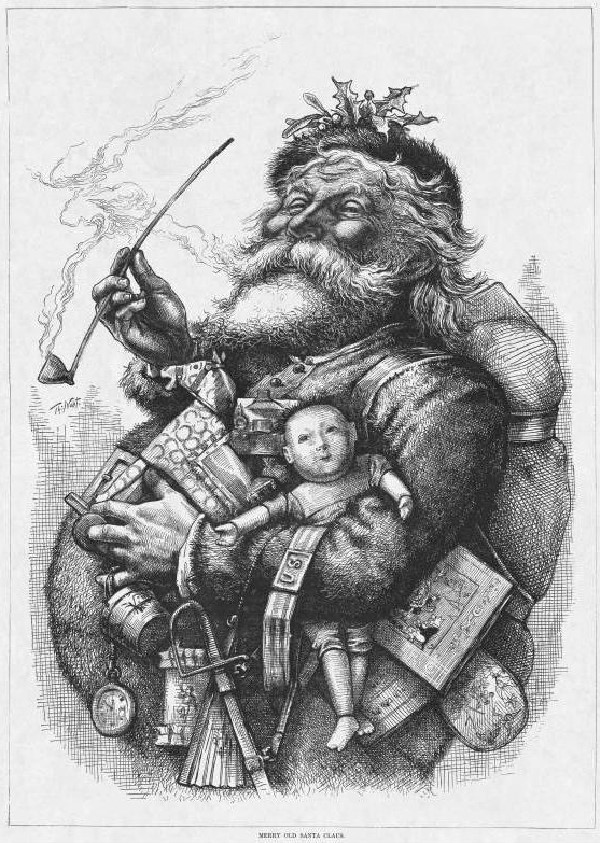With only three days left until Christmas, our latest Vintage Style post considers the style of Santa Claus. His defining dress is the product of several hundred years of ancient folklore and Pagan ritual meeting a Christian celebration, and picking
Santa Claus and his defining dress are the product of several hundred years of ancient folklore and Pagan ritual meeting a Christian celebration, and picking up a saint along the way. The legend of Father Christmas accelerated at its fastest rate over the past 200 years or so due, predominantly, to migration from European countries, steeped in tradition, to the United States.
The U.S. ports in New York and Boston were where European migrants arrived, bringing with them Germanic notions of the pre-Christian legend of Odin – a large bearded character who led hunting missions through the sky. In Dutch stories of Odin, the figure would wear a long red cape or chasuble over a traditional white bishop's alb – a nod, perhaps, to Saint Nicholas, the AD 270 Bishop of Myra (the non-biblical saint whose story is another ingredient in the stew that is the legend of Santa Claus).
In 1821 a member of The New York Historical Society, an academic professor and European Folklore specialist who also happened to be a poet, drew on the accounts of western folklore to solidify one of the first incarnations of the modern day Santa Claus – in concept at least. Clement Moore wrote the now-famous poem The Night Before Christmas initially for his children.
Moore wrote that St. Nicholas was “dressed all in fur”; “His cheeks were like roses”; “And the beard of his chin was white as snow”; and “He had a broad face and a little round belly”. Perhaps not first conceived by Moore, but certainly setting a new precedent. This conception of the modern benevolent fat man in red and white gave way to visual interpretations by a succession of American artists and illustrators.
"Santa Claus’s look may have its origins in a mysterious tangling of European folklore, but it was The United States that would pin it down to the white beard, red suit with fur trims, black boots and a wide belt and sell the legend back to the world"
A sketchy incarnation of Santa appeared in New York’s Harper’s Weekly in the early 1860s. The Illustrations were by the German-born Thomas Nast, who emigrated to the States in 1846. Visually, Nast drew on traditions from his native Germany, but, working at the time of the civil war, his illustrations were deeply anti-confederate. In 1863 Nast drew Santa for Harpers. Here, he was a rotund and white-bearded fellow dressed in a stars and stripes suit as he gave presents to children and soldiers at a Union camp whilst holding a figure of Jefferson Davis with a string around his neck – lynching the confederates.
Nast’s Santa Claus was not, in fact, the first visual incarnation of Santa – proven by subsequent discoveries of similar, earlier Santa-style drawings – but it was one of the most famous and became a universal point of reference. A 1921 cover for The Country Gentleman magazine featured an illustration by Norman Rockwell. Here, Santa Claus holds a drum and a note that reads, “A drum for Tommy”, referencing, again, European folklore and the legend of Saint Nicholas.
The most recognisable modern Santa came via the drinks brand Coca-Cola. Contrary to popular Coke-lore, Coca-Cola didn’t make Santa Claus red. He was still depicted in beige, purple and green as well as red. In a bid to sell the quenching drink in chillier climbs, Coca-Cola adopted Santa Claus as their unofficial winter mascot. Coca-Cola may not have made Santa red but it did popularise a certain version of Santa and sell it in as palatable a form as its sugary liquid gold.
The most recognisable “holidays-are-coming" image of Santa derives from a 1930 illustration by the Michigan-born artist Haddon Sundblom. His Santa Claus, bearded and round, dressed in red and white with a rosy face, solidified all the previous Santa iconography. It was around this time that Coca-Cola began promoting their product, with the help of Santa, at American shopping malls – the trend for Santa appearing at shops in England followed not long after.
Santa Claus’s look may have its origins in a mysterious tangling of European folklore, but it was The United States that would pin it down to the white beard, red suit with fur trims, black boots and a wide belt and sell the legend back to the world. This was, perhaps, the earliest example of the commercialisation and commoditisation the young country would become synonymous with over the following centuries.
Text by Laura Havlin
